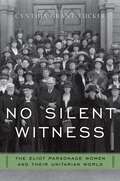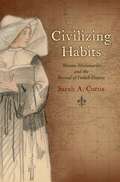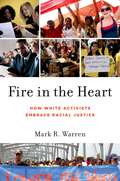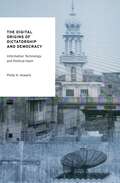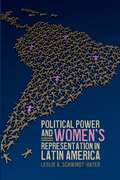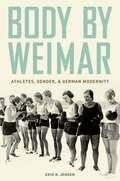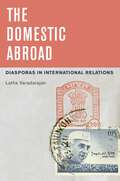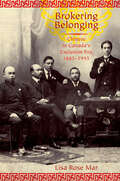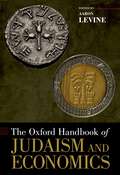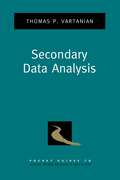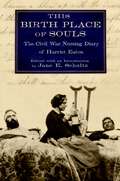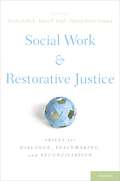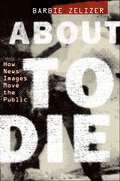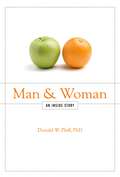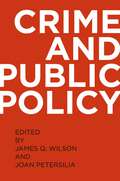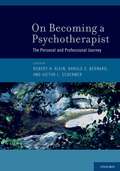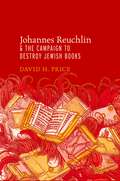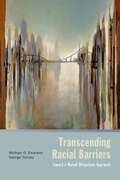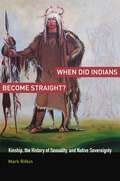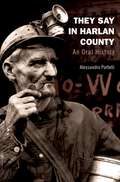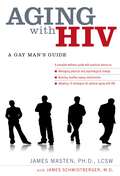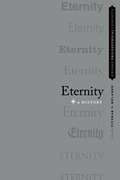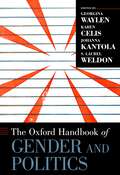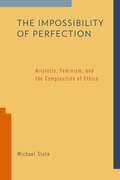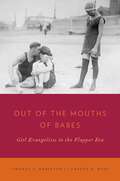- Table View
- List View
No Silent Witness: The Eliot Parsonage Women and Their Unitarian World (Religion in America)
by Cynthia Grant TuckerThis group biography follows three generations of ministers' daughters and wives in a famed American Unitarian family. Cynthia Tucker examines the Eliots, their religious tradition, and the Eliot women's largely neglected female vocation. Spanning 150 years from the early 19th century forward, the narrative is shaped into a series of stories. Each of six chapters takes up a different woman's experience, from the deaths of numerous children and the anguish of infertility to the suffocation of small parish life with its chronic loneliness, doubt, and resentment.
Civilizing Habits: Women Missionaries and the Revival of French Empire
by Sarah A. CurtisCivilizing Habits explores the life stories of three French women missionaries--Philippine Duchesne, Emilie de Vialar, and Anne-Marie Javouhey--who crossed boundaries, both real and imagined, to evangelize far from France's shores. In so doing, they helped France reestablish a global empire after the dislocation of the Revolution and the fall of Napoleon. They also pioneered a new missionary era in which the educational, charity, and health care services provided by women became valuable tools for spreading Catholic influence across the globe. Philippine Duchesne traveled to former French territory in Missouri in 1818 to proselytize among Native Americans. Thwarted by the American policy of removing tribes even further west, she turned her attention to girls' education on the frontier. Emilie de Vialar followed French troops to Algeria after its conquest and opened missions throughout the Mediterranean basin in the mid-nineteenth century. Prevented from direct evangelization, she developed strategies and subterfuges for working among Muslim populations. Anne-Marie Javouhey evangelized among Africans in the French slave colonies, including a utopian settlement in the wilds of French Guiana. She became a rare Catholic proponent of the abolition of slavery and a woman designated a "great man" by the French king. Paradoxically, through embracing religious institutions designed to shield their femininity, these women gained increased authority to travel outside France, challenge church power, and evangelize among non-Christians, all roles more commonly ascribed to male missionaries. Their stories teach us about the life paths open to religious women in the nineteenth century and how both church and state benefitted from their initiative to expand the boundaries of faith and nation.
Fire in the Heart: How White Activists Embrace Racial Justice (Oxford Studies in Culture and Politics)
by Mark R. WarrenFire in the Heart uncovers the dynamic processes through which some white Americans become activists for racial justice. The book reports powerful accounts of the development of racial awareness drawn from in-depth interviews with fifty white activists in the fields of community organizing, education, and criminal justice reform. Drawing extensively on the rich interview material, Mark Warren shows how white Americans can develop a commitment to racial justice, not just because it is the right thing to do, but because they embrace the cause as their own. Contrary to much contemporary thinking on racial issues focused on altruism or interests, Warren finds that cognitive and rational processes alone do little to move whites to action. Rather, the motivation to take and sustain action for racial justice is profoundly moral and relational. Warren shows how white activists come to find common cause with people of color when their core values are engaged, as they build relationships with people of color that lead to caring, and when they develop a vision of a racially just future that they understand to benefit everyone--themselves, other whites, and people of color. Warren also considers the complex dynamics and dilemmas white people face in working in multiracial organizations committed to systemic change in America's racial order, and provides a deeper understanding and appreciation of the role that white people can play in efforts to promote racial justice. The first study of its kind, Fire in the Heart brings to light the perspectives of white people who are working day-to-day to build not a post-racial America but the foundations for a truly multiracial America rooted in a caring, human community with equity and justice at its core.
The Digital Origins of Dictatorship and Democracy: Information Technology and Political Islam (Oxford Studies in Digital Politics)
by Philip N. HowardAround the developing world, political leaders face a dilemma: the very information and communication technologies that boost economic fortunes also undermine power structures. Globally, one in ten internet users is a Muslim living in a populous Muslim community. In these countries, young people are developing political identities online, and digital technologies are helping civil society build systems of political communication independent of the state and beyond easy manipulation by cultural or religious elites. With unique data on patterns of media ownership and technology use, The Digital Origins of Dictatorship and Democracy demonstrates how, since the mid-1990s, information technologies have had a role in political transformation. Democratic revolutions are not caused by new information technologies. But in the Muslim world, democratization is no longer possible without them.
Political Power and Women's Representation in Latin America
by Leslie A. Schwindt-BayerThe number of women elected to Latin American legislatures has grown significantly over the past thirty years. This increase in the number of women elected to national office is due, in large part, to gender-friendly electoral rules such as gender quotas and proportional electoral systems, and it has, in turn, fostered constituent support for representative democracy. Still, this book argues that women are gaining political voice and bringing women's issues to state agendas, but they are not gaining political power. Women are marginalized by the male majority in office and relegated to the least powerful committees and leadership posts, hindering progress toward real political equality. In Political Power and Women's Representation in Latin America, Leslie Schwindt-Bayer examines the causes and consequences of women's representation in Latin America. She does so by asking a series of politically relevant and theoretically challenging questions, including why the numbers of women in office have increased in some countries but vary across others; what the presence of women in office means for the way representatives legislate; and what consequences the election of women bears for representative democracy more generally. Schwindt-Bayer articulates a comprehensive theory of women's representation that analyzes and connects trends in relation to four facets of political representation: formal, descriptive, substantive and symbolic. She then tests this theory empirically using aggregate data from all eighteen Latin American democracies and original fieldwork in Argentina, Colombia and Costa Rica. Ultimately, this book communicates the complex and often incomplete nature of women's political representation in Latin America.
Body by Weimar: Athletes, Gender, and German Modernity
by Erik N. JensenSee the author featured in the "New Books in History" podcast: http://newbooksinhistory.com/2011/04/01/erik-jensen-body-by-weimar-athletes-gender-and-german-modernity-oxford-up-2010/ In Body by Weimar, Erik N. Jensen shows how German athletes reshaped gender roles in the turbulent decade after World War I and established the basis for a modern body and modern sensibility that remain with us to this day. The same cutting-edge techniques that engineers were using to increase the efficiency of factories and businesses in the 1920s aided athletes in boosting the productivity of their own flesh and bones. Sportswomen and men embodied modernity-quite literally-in its most streamlined, competitive, time-oriented form, and their own successes on the playing fields seemed to prove the value of economic rationalization to a skeptical public that often felt threatened by the process. Enthroned by the media as culture's trendsetters, champions in sports such as tennis, boxing, and track and field also provided models of sexual empowerment, social mobility, and self-determination. They showed their fans how to be modern, and, in the process, sparked heated debates over the aesthetics of the body, the limits of physical exertion, the obligations of citizens to the state, and the relationship between the sexes. If the images and debates in this book strike readers as familiar, it might well be because the ideal body of today-sleek, efficient, and equally available to men and women-received one of its earliest articulations in the fertile tumult of Germany's roaring twenties. After more than eighty years, we still want the Weimar body.
The Domestic Abroad: Diasporas in International Relations
by Latha VaradarajanIn the past few decades, and across disparate geographical contexts, states have adopted policies and initiatives aimed at institutionalizing relationships with "their" diasporas. These practices, which range from creating new ministries to granting dual citizenship, are aimed at integrating diasporas as part of a larger "global" nation that is connected to, and has claims on the institutional structures of the home state. Although links, both formal and informal, between diasporas and their presumptive homelands have existed in the past, the recent developments constitute a far more widespread and qualitatively different phenomenon. In this book, Latha Varadarajan theorizes this novel and largely overlooked trend by introducing the concept of the "domestic abroad." Varadarajan demonstrates that the remapping of the imagined boundaries of the nation, the visible surface of the phenomenon, is intrinsically connected to the political-economic transformation of the state that is typically characterized as "neoliberalism." The domestic abroad must therefore be understood as the product of two simultaneous, on-going processes: the diasporic re-imagining of the nation and the neoliberal restructuring of the state. The argument unfolds through a historically nuanced study of the production of the domestic abroad in India. The book traces the complex history and explains the political logic of the remarkable transition from the Indian state's guarded indifference toward its diaspora in the period after independence, to its current celebrations of the "global Indian nation." In doing so, The Domestic Abroad reveals the manner in which the boundaries of the nation and the extent of the authority of the state, in India and elsewhere, are dynamically shaped by the development of capitalist social relations on both global and national scales.
Brokering Belonging: Chinese in Canada's Exclusion Era, 1885-1945
by Lisa Rose MarBrokering Belonging traces several generations of Chinese "brokers," ethnic leaders who acted as intermediaries between the Chinese and Anglo worlds of Canada. Before World War II, most Chinese could not vote and many were illegal immigrants, so brokers played informal but necessary roles as representatives to the larger society. Lisa Rose Mar's study of Chinatown leaders shows how politics helped establish North America's first major group of illegal immigrants. Drawing on new Chinese language evidence, her dramatic account of political power struggles over representing Chinese Canadians offers a transnational immigrant view of history, centered in a Pacific World that joins Canada, the United States, China, and the British Empire.
The Oxford Handbook of Judaism and Economics (Oxford Handbooks)
The interaction of Judaism and economics encompasses many different dimensions. Much of this interaction can be explored through the way in which Jewish law accommodates and even enhances commercial practice today and in past societies. From this context, The Oxford Handbook of Judaism and Economics explores how Judaism as a religion and Jews as a people relate to the economic sphere of life in modern society as well as in the past. Bringing together an astonishingly strong group of top scholars, the volume approaches the subject from a variety of angles, providing one of the most comprehensive, well-rounded, and authoritative accounts of the intersections of Judaism and economics yet produced. Aaron Levine first offers a brief overview of the nature and development of Jewish law as a legal system, then presents essays from a variety of angles and areas of expertise. The book offers contributions on economic theory in the bible and in the Talmud; on the interaction between Jewish law, ethics, modern society, and public policy; then presents illuminating explorations of Judaism throughout economic history and the ways in which economics has influenced Jewish history. The Oxford Handbook of Judaism and Economics at last offers an extensive and welcome resource by leading scholars and economists on the vast and delightfully complex relationship between economics and Judaism.
Secondary Data Analysis (Pocket Guide to Social Work Research Methods)
by Thomas P. VartanianIn recent decades, social work and other social science research disciplines have become increasingly reliant on large secondary data sets, which have increased in both number and accessibility. When starting a new research project, how does one determine whether to use a secondary data set? Which of the thousands available should be used? This invaluable and expertly written guide provides an in-depth introduction to 29 of the most widely used data sets in social work, such as the Early Childhood Longitudinal Study, the National Health and Nutrition Examination Survey, and the U.S. Census. This book also examines the years covered by these cross-sectional and longitudinal data sets, the units of analysis, and the sample sizes. Readers will learn where to find the data and the key variables contained within, and how to use them in SAS and Stata. Screen shots guide researchers through data sets in a step-by-step process: how to download the data, how to merge it with other data sets, and how to program it when necessary. Each section also profiles studies that have used the respective data sets, giving researchers a clear feel for the depth and range of questions that a given data source can be used to answer, like the use of government data to explore issues ranging from pathways out of poverty to the relationship between marital dissolution and women's health and well-being. Exceptionally well calibrated and filled with real-world examples, this pocket guide will give beginning and advanced researchers a comprehensive understanding of these data sets that they can use in their research on clinical, policy, and other types studies.
This Birth Place of Souls: The Civil War Nursing Diary of Harriet Eaton
by Jane E. SchultzAfter the battle of Antietam in 1862, Harriet Eaton traveled to Virginia from her home in Portland, Maine, to care for soldiers in the Army of the Potomac. Portland's Free Street Baptist Church, with liberal ties to abolition, established the Maine Camp Hospital Association and made the widowed Eaton its relief agent in the field. One of many Christians who believed that patriotic activism could redeem the nation, Eaton quickly learned that war was no respecter of religious principles. Doing the work of nurse and provisioner, Eaton tended wounded men and those with smallpox and diphtheria during two tours of duty. Eaton struggled with the disruptions of transience, scarcely sleeping in the same place twice, but found the politics of daily toil even more challenging. Conflict between Eaton and coworker Isabella Fogg erupted almost immediately over issues of propriety. Though Eaton praised some of the surgeons with whom she worked, she labeled others charlatans whose neglect had deadly implications for the rank and file. If she saw villainy, she also saw opportunities to convert soldiers and developed an intense spiritual connection with a private, which appears to have led to a postwar liaison. Published here for the first time, the uncensored nursing diary is a rarity among medical accounts of the war, showing Eaton to be an astute observer of human nature and not as straight-laced as we might have thought. This edition includes an extensive introduction by the editor, transcriptions of relevant letters and newspaper articles, and a comprehensive biographical dictionary of the people mentioned in the diary.
Social Work and Restorative Justice: Skills for Dialogue, Peacemaking, and Reconciliation
by Elizabeth Beck Nancy P. Kropf Pamela Blume LeonardPresents an innovative, synergistic practice model that will help social workers use restorative justice skills to facilitate healing and recovery in the families and communities that they serve.
About to Die: How News Images Move the Public
by Barbie ZelizerDue to its ability to freeze a moment in time, the photo is a uniquely powerful device for ordering and understanding the world. But when an image depicts complex, ambiguous, or controversial events--terrorist attacks, wars, political assassinations--its ability to influence perception can prove deeply unsettling. Are we really seeing the world "as it is" or is the image a fabrication or projection? How do a photo's content and form shape a viewer's impressions? What do such images contribute to historical memory? About to Die focuses on one emotionally charged category of news photograph--depictions of individuals who are facing imminent death--as a prism for addressing such vital questions. Tracking events as wide-ranging as the 1906 San Francisco Earthquake, the Holocaust, the Vietnam War, and 9/11, Barbie Zelizer demonstrates that modes of journalistic depiction and the power of the image are immense cultural forces that are still far from understood. Through a survey of a century of photojournalism, including close analysis of over sixty photos, About to Die provides a framework and vocabulary for understanding the news imagery that so profoundly shapes our view of the world.
Man and Woman: An Inside Story
by Donald W. Pfaff, PhDThe saga of sex differences in brain and behavior begins with a tiny sperm swimming toward a huge egg, to contribute its tiny Y chromosome plus its copies of the other chromosomes. Genetic, anatomic and physiologic alterations in the male ensue, making his brain and behavior different in specific respects from his sister. Brain-wise, specific cell groups develop differently in males compared to females, in some cases right after birth and in other cases at puberty. But genetics and neuroanatomy do not dominate the scene. Prenatal stress, postnatal stress and lousy treatment at puberty all can affect males and females in different ways. The upshot of all these genetic and environmental factors produces small sex differences in certain abilities and huge sex differences in feelings, in pain and in suffering. Put this all together and the reader will see that biological and cultural influences on gender roles operate at so many different levels to influence behavioral mechanisms that gender role choices are flexible, reversible and non-dichotomous, especially in modern societies.
Crime and Public Policy
Crime in the United States has fluctuated considerably over the past thirty years, as have the policy approaches to deal with it. During this time criminologists and other scholars have helped to shed light on the role of incarceration, prevention, drugs, guns, policing, and numerous other aspects to crime control. Yet the latest research is rarely heard in public discussions and is often missing from the desks of policymakers. This book accessibly summarizes the latest scientific information on the causes of crime and evidence about what does and does not work to control it. Thoroughly revised and updated, this new version of Crime and Public Policy will include twenty chapters and five new substantial entries. As with previous editions, each essay reviews the existing literature, discusses the methodological rigor of the studies, identifies what policies and programs the studies suggest, and then points to policies now implemented that fail to reflect the evidence. The chapters cover the principle institutions of the criminal justice system (juvenile justice, police, prisons, probation and parole, sentencing), how broader aspects of social life inhibit or encourage crime (biology, schools, families, communities), and topics currently generating a great deal of attention (criminal activities of gangs, sex offenders, prisoner reentry, changing crime rates). With contributions from trusted, leading scholars, Crime and Public Policy offers the most comprehensive and balanced guide to how the latest and best social science research informs the understanding of crime and its control for policymakers, community leaders, and students of crime and criminal justice.
On Becoming a Psychotherapist: The Personal and Professional Journey
by Robert H. Klein Harold S. Bernard Victor L. SchermerOn Becoming a Psychotherapist explores how psychotherapists develop as practitioners through both professional training and the training that can only be obtained through personal experience.
Johannes Reuchlin and the Campaign to Destroy Jewish Books
by David H. PriceThe early sixteenth century saw a major crisis in Christian-Jewish relations: the attempt to confiscate and destroy every Jewish book in Germany. This unprecedented effort to end the practice of Judaism throughout the empire was challenged by Jewish communities, and, unexpectedly, by Johannes Reuchlin (1455-1522), the founder of Christian Hebrew studies. In 1510, Reuchlin wrote an extensive, impassioned, and ultimately successful defense of Jewish writings and legal rights, a stunning intervention later acknowledged by a Jewish leader as a ''miracle within a miracle.'' The fury that greeted Reuchlin's defense of Judaism resulted in a protracted heresy trial that polarized Europe. The decade-long controversy promoted acceptance of humanist culture in northern Europe and, in several key settings, created an environment that was receptive to the nascent Reformation movement. The legal and theological battles over charges that Reuchlin's positions were "impermissibly favorable to Jews," a conflict that elicited intervention on both sides from the most powerful political and intellectual leaders in Renaissance Europe, formed a new context for Christian reflection on Judaism. David H. Price offers insight into important Christian discourses on Judaism and anti-Semitism that emerged from the clash of Renaissance humanism with this potent anti-Jewish campaign, as well as an innovative analysis of Luther's virulent anti-Semitism in the context and aftermath of the Reuchlin Affair. This book is a valuable contribution to study of an important and complex development in European history: Christians acquiring accurate knowledge of Judaism and its history.
Transcending Racial Barriers: Toward a Mutual Obligations Approach
by Michael O. Emerson George YanceyDespite recent progress against racial inequalities, American society continues to produce attitudes and outcomes that reinforce the racial divide. In Transcending Racial Barriers, Michael Emerson and George Yancey offer a fresh perspective on how to combat racial division. They document the historical move from white supremacy to institutional racism, then look at modern efforts to overcome the racialized nature of our society. The authors argue that both conservative and progressive approaches have failed, as they continually fall victim to forces of ethnocentrism and group interest. They then explore group interest and possible ways to account for the perspectives of both majority and minority group members. They look to multiracial congregations, multiracial families, the military, and sports teams-all situations in which group interests have been overcome before. In each context they find the development of a core set of values that binds together different racial groups, along with the flexibility to express racially-based cultural uniqueness that does not conflict with this critical core. Transcending Racial Barriers offers what is at once a balanced approach towards dealing with racial alienation and a bold step forward in the debate about the steps necessary to overcome present-day racism.
When Did Indians Become Straight?: Kinship, the History of Sexuality, and Native Sovereignty
by Mark RifkinWhen Did Indians Become Straight? explores the complex relationship between contested U.S. notions of normality and shifting forms of Native American governance and self-representation. Examining a wide range of texts (including captivity narratives, fiction, government documents, and anthropological tracts), Mark Rifkin offers a cultural and literary history of the ways Native peoples have been inserted into Euramerican discourses of sexuality and how Native intellectuals have sought to reaffirm their peoples' sovereignty and self-determination.
They Say in Harlan County: An Oral History (Oxford Oral History Series)
by Alessandro PortelliMade famous in the 1976 documentary Harlan County USA, this pocket of Appalachian coal country has been home to generations of miners--and to some of the most bitter labor battles of the 20th century. It has also produced a rich tradition of protest songs and a wealth of fascinating culture and custom that has remained largely undiscovered by outsiders, until now. They Say in Harlan County is not a book about coal miners so much as a dialogue in which more than 150 Harlan County women and men tell the story of their region, from pioneer times through the dramatic strikes of the 1930s and '70s, up to the present. Alessandro Portelli draws on 25 years of original interviews to take readers into the mines and inside the lives of those who work, suffer, and often die in them--from black lung, falling rock, suffocation, or simply from work that can be literally backbreaking. The book is structured as a vivid montage of all these voices--stoic, outraged, grief-stricken, defiant--skillfully interwoven with documents from archives, newspapers, literary works, and the author's own participating and critical voice. Portelli uncovers the whole history and memory of the United States in this one symbolic place, through settlement, civil war, slavery, industrialization, immigration, labor conflict, technological change, migration, strip mining, environmental and social crises, and resistance. And as hot-button issues like mountain-top removal and the use of "clean coal" continue to hit the news, the history of Harlan County--especially as seen through the eyes of those who lived it--is becoming increasingly important. With rare emotional immediacy, gripping narratives, and unforgettable characters, They Say in Harlan County tells the real story of a culture, the resilience of its people, and the human costs of coal mining.
Aging with HIV: A Gay Man's Guide
by James MastenWith improvements in the treatment of HIV disease, gay men in great numbers are surviving--and thriving--into middle and older age. While increased longevity brings new hope, it also raises unanticipated challenges, particularly for gay men who never thought they would live this long: How do I deal with all the physical changes? Who can I rely on as I get older? Is a relationship still in the cards for me? What about sex? How should I prepare for old age? A one-of-a-kind guide for gay men aging with HIV, Aging with HIV offers an upbeat, down-to-earth approach for adapting to change, whether driven by age, AIDS, or both. Psychotherapist James Masten and physician James Schmidtberger shed light on the many common assumptions and fears of aging with HIV. Aging with HIV provides concrete solutions for facing midlife with a positive outlook, offering a wealth of advice for breaking unhealthy habits and coping mechanisms. The book describes the nine changes common to gay men as they age with HIV, discusses the four challenges of aging, and offers a unique ten-step path to optimal aging with HIV, helping the reader to tailor the book's suggestions to the realities of their lives. Woven throughout the book are first-person narratives from men who recount what worked--and did not work--for them. In addition, Rapid Research, Fast Fact, and Self-Reflection boxes highlight the latest research and challenge readers to take stock of the present--and plan for the future. An invaluable tool to keep handy and to refer to often, Aging with HIV is an inviting, confident companion to navigating midlife and beyond with HIV.
Eternity: A History (Oxford Philosophical Concepts)
Eternity is a unique kind of existence that is supposed to belong to the most real being or beings. It is an existence that is not shaken by the common wear and tear of time. Over the two and half millennia history of Western philosophy we find various conceptions of eternity, yet one sharp distinction between two notions of eternity seems to run throughout this long history: eternity as timeless existence, as opposed to eternity as existence in all times. Both kinds of existence stand in sharp contrast to the coming in and out of existence of ordinary beings, like hippos, humans, and toothbrushes: were these eternally-timeless, for example, a hippo could not eat, a human could not think or laugh, and a toothbrush would be of no use. Were a hippo an eternal-everlasting creature, it would not have to bother itself with nutrition in order to extend its existence. Everlasting human beings might appear similar to us, but their mental life and patterns of behavior would most likely be very different from ours. The distinction between eternity as timelessness and eternity as everlastingness goes back to ancient philosophy, to the works of Plato and Aristotle, and even to the fragments of Parmenides' philosophical poem. In the twentieth century, it seemed to go out of favor, though one could consider as eternalists those proponents of realism in philosophy of mathematics, and those of timeless propositions in philosophy of language (i.e., propositions that are said to exist independently of the uttered sentences that convey their thought-content). However, recent developments in contemporary physics and its philosophy have provided an impetus to revive notions of eternity due to the view that time and duration might have no place in the most fundamental ontology. The importance of eternity is not limited to strictly philosophical discussions. It is a notion that also has an important role in traditional Biblical interpretation. The Tetragrammaton, the Hebrew name of God considered to be most sacred, is derived from the Hebrew verb for being, and as a result has been traditionally interpreted as denoting eternal existence (in either one of the two senses of eternity). Hence, Calvin translates the Tetragrammaton as 'l'Eternel', and Mendelssohn as 'das ewige Wesen' or 'der Ewige'. Eternity also plays a central role in contemporary South American fiction, especially in the works of J.L. Borges. The representation of eternity poses a major challenge to both literature and arts (just think about the difficulty of representing eternity in music, a thoroughly temporal art). The current volume aims at providing a history of the philosophy of eternity surrounded by a series of short essays, or reflections, on the role of eternity and its representation in literature, religion, language, liturgy, science, and music. Thus, our aim is to provide a history of philosophy as a discipline that is in constant commerce with various other domains of human inquisition and exploration.
The Oxford Handbook of Gender and Politics (Oxford Handbooks)
As a field of scholarship, gender and politics has exploded over the last fifty years and is now global, institutionalized, and ever expanding. The Oxford Handbook of Gender and Politics brings to political science an accessible and comprehensive overview of the key contributions of gender scholars to the study of politics and shows how these contributions produce a richer understanding of polities and societies. Like the field it represents, the handbook has a broad understanding of what counts as political and is based on a notion of gender that highlights masculinities as well as femininities, thereby moving feminist debates in politics beyond the focus on women. It engages with some of the key aspects of political science as well as important themes in gender and feminist research (such as sexuality and body politics), thereby forging a dialogue between gender studies in politics and mainstream political science. The handbook is organized in sections that look at sexuality and body politics; political economy; civil society; participation, representation and policymaking; institutions, states and governance as well as nation, citizenship and identity. The Oxford Handbook of Gender and Politics contains and reflects the best scholarship in its field.
The Impossibility of Perfection: Aristotle, Feminism, and the Complexities of Ethics
by Michael SloteMost people think that the difficulty of balancing career and personal/family relationships is the fault of present-day society or is due to their own inadequacies. But in this major new book, eminent moral philosopher Michael Slote argues that the difficulty runs much deeper, that it is due to the essential nature of the divergent goods involved in this kind of choice. He shows more generally that perfect human happiness and perfect virtue are impossible in principle, a view originally enunciated by Isaiah Berlin, but much more thoroughly and synoptically defended here than ever before. Ancient Greek and modern-day Enlightenment thought typically assumed that perfection was possible, and this is also true of Romanticism and of most recent ethical theory. But if, as Slote maintains, imperfection is inevitable, then our inherited categories of virtue and personal good are far too limited and unqualified to allow us to understand and cope with the richer and more complex life that characterizes today's world. And The Impossibility of Perfection argues in particular that we need some new notions, new distinctions, and even new philosophical methods in order to distill some of the ethical insights of recent feminist thought and arrive at a fuller and more realistic picture of ethical phenomena.
Out of the Mouths of Babes: Girl Evangelists in the Flapper Era (Religion in America)
by Thomas A. Robinson Lanette D. RuffThe 1920s saw one of the most striking revolutions in manners and morals to have marked North American society, affecting almost every aspect of life, from dress and drink to sex and salvation. Protestant Christianity was being torn apart by a heated controversy between traditionalists and the modernists, as they sought to determine how much their beliefs and practices should be altered by scientific study and more secular attitudes. Out of the controversy arose the Fundamentalist movement, which has become a powerful force in twentieth-century America. During this decade, hundreds (and perhaps thousands) of young girl preachers, some not even school age, joined the conservative Christian cause, proclaiming traditional values and condemning modern experiments with the new morality. Some of the girls drew crowds into the thousands. But the stage these girls gained went far beyond the revivalist platform. The girl evangelist phenomenon was recognized in the wider society as well, and the contrast to the flapper worked well for the press and the public. Girl evangelists stood out as the counter-type of the flapper, who had come to define the modern girl. The striking contrast these girls offered to the racy flapper and to modern culture generally made girl evangelists a convenient and effective tool for conservative and revivalist Christianity, a tool which was used by their adherents in the clash of cultures that marked the 1920s.
